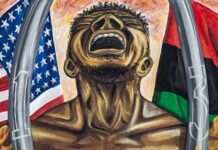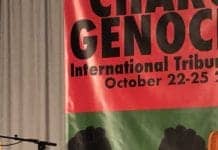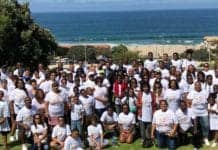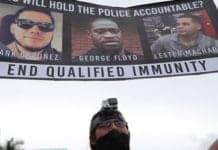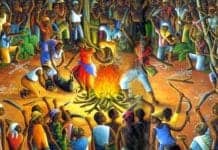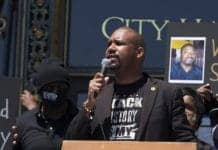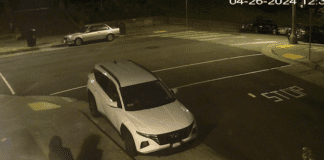by Malaika Kambon
It is hot enough in Corcoran, California, to melt people.
That being said, it still wasn’t hot enough to keep upwards of 400 people from braving 103-degree weather to mobilize and rally at Corcoran State Prison in support of over 30,000 prisoners on hunger strike in California. The immediate goal is to stop the cruelty and torture that being held in isolation represents.
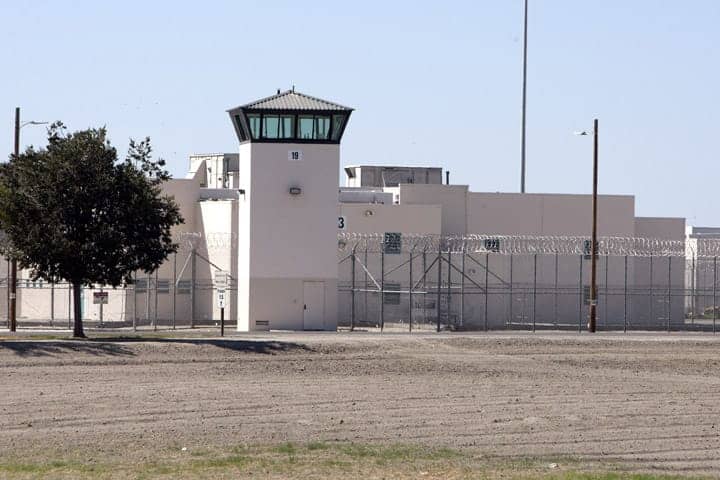
“Our indefinite isolation here is both inhumane and illegal, and the proponents of the prison industrial complex are hoping that their campaign to dehumanize us has succeeded to the degree that you don’t care and will allow the torture to continue in your name. It is our belief that they have woefully underestimated the decency, principles and humanity of the people. Join us in opposing this injustice without end.”
“Injustice without end.” These are prophetic words written by the NCTT, a New Afrikan (Black) collective think tank in the Corcoran SHU, men caged in the 4B-1C section of the SHU (security housing unit), the super-max isolation hellhole at Corcoran State Prison.
The brutal facts that are known do not begin to state all of the issues:
- 7 percent of all California prisoners are in isolation;
- 30 percent of prisoner suicides happen in isolation units;
- 51 percent of Pelican Bay Security Housing Unit (SHU) prisoners have spent at least five years in solitary confinement;
- 89 percent of prisoners in solitary confinement have been there for at least 20 years;
- 6 feet by 8 feet are the dimensions of the average person’s walk-in closet in the U.S., yet 11 feet 7 inches by 7 feet 7 inches are the dimensions of a SHU cell at Pelican Bay;
- 11,730 prisoners are held in solitary confinement in California prisons today.

Prisoners are held in solitary confinement for up to 24 hours per day and experience physical and mental torture, which often takes the form of a wide range of emotions including but not limited to depression, hopelessness, antipathy, extreme anxiety, humiliation, anger, and chronic insomnia.
When these conditions are experienced on a daily basis – for decades – it amounts to cruel and unusual punishment which has nothing whatever to do with punitive measures, particularly punitive measures instigated in response to laws that are racist and dysfunctional in their inceptions.
What matters the U.S. Constitution’s Eighth Amendment prohibition against cruel and unusual punishment when its 13th Amendment reads: “Neither slavery nor involuntary servitude, except as a punishment for crime whereof the party shall have been duly convicted, shall exist within the United States, or any place subject to their jurisdiction.”
The 13th, 14th and 15th Amendments to the U.S. Constitution were approved by Congress and ratified by the states after the Civil War. Known collectively as the Civil War Amendments, they were designed to protect individual rights. The 13th Amendment forbids involuntary servitude or slavery, except where the condition is imposed on an individual “as a punishment for crime?”
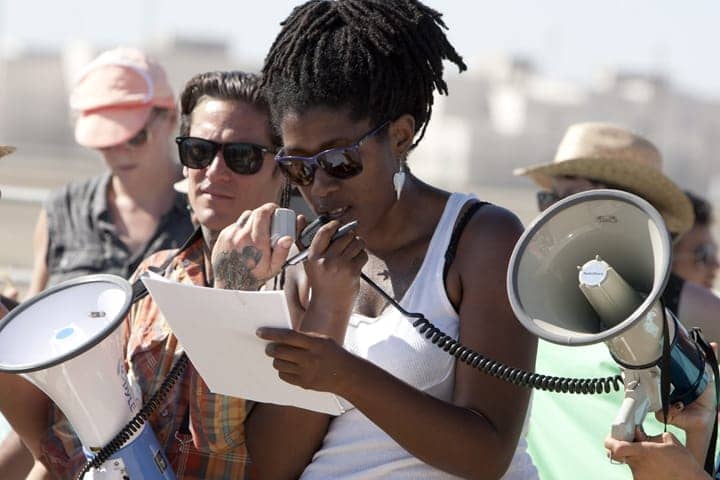
Mumia Abu-Jamal has been in general population since Jan. 26, 2012. The state nonetheless continues its attempts to harass, silence, isolate – i.e., lynch him, figuratively, legally and literally – after first secretly sentencing him to life imprisonment without parole. This is their retaliation for his continued indictments of U.S. imperialism via film, journalism and political commitment.
What matters innocence? What matters proof of guilt? In a draconian society gone mad, neither innocence nor proof of innocence exists. Proof can be bought, sold, twisted, exchanged, invented, extinguished, executed – or made to disappear.
And the U.S. government weighs in heavy on utilizing the disappear option.
In point of fact, prisons have not ever been an effective crime preventative or deterrent. But they have always been inhumane, illegal and a homegrown feature of U.S. capitalism and imperialist expansion since their inception.
Capitalist expansion was built upon the backs of enslaved Afrikans.
Enslavement is the embodiment of imprisonment. Euro-AmeriKKKan enslavement is an ongoing Afrikan holocaust. That holocaust began with the chattel enslavement of Afrikan people by Europeans in 1438. Between 1438 and the declared end of chattel slavery in 1863, 42 slave fortresses (prisons) were built along the coast of West Afrika – 36 of these, beginning with Elmina Castle, along the coast of Ghana. Some of these so-called castles are still standing.
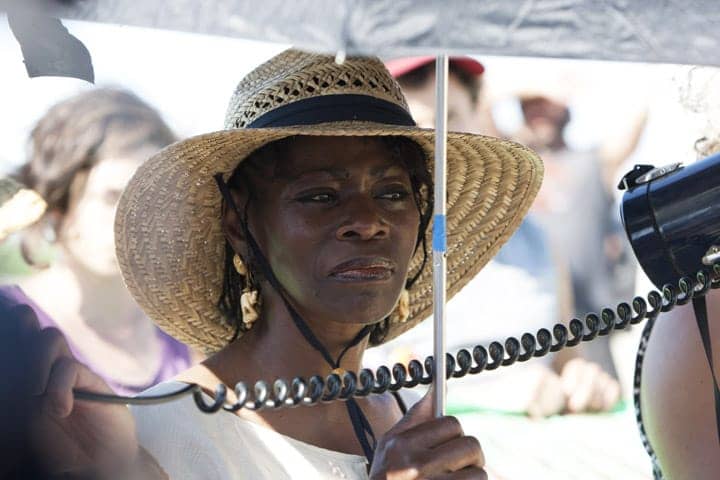
He set in motion an era of protracted genocide that continues worldwide to this day in many forms and permutations. According to Ancestor Dr. John Henrik Clarke in “Christopher Columbus and the Afrikan Holocaust,” “The greatest destroyer of Afrikan culture, the greatest exploiter of the Afrikan was the plantation system of the New World. The Afrikan was transformed into something called the Negro. The Afrikan was demeaned (Page 83).”
Plantation system: read “prison,” “slave ships,” “prisons,” “slavocracy,” “dehumanization and death.”
1492, Christopher Columbus landed in what is now Haiti, after having sailed up and down the Guinea coast for 23 years. What was he doing sailing up and down the Guinea coast for 23 years? He was part of the Portuguese slave trade.
Twenty to 30 million Afrikan lives later, and contrary to popular belief, the fabled Emancipation Proclamation executive order issued by Abraham Lincoln on Jan. 1, 1863, did not free Afrikan people. It merely redesigned the crucible in which enslavement could be re-forged, minus the physical chains. The PBS documentary, “Slavery by Another Name,” recounts the history of how “post-Emancipation” labor practices and laws created new forms of slavery that persisted from 1865 until well into the 20th century.”
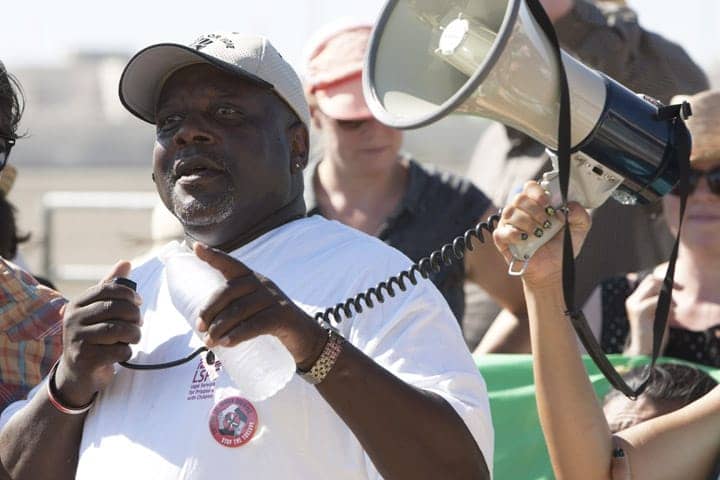
In the blinding crucible of their sacrifices, their fight must be our fight.
We must remember the words of our Ancestor James Baldwin, written Nov. 19, 1970, in a letter to Angela Y Davis:
“We know that we, the Blacks, and not only we, the Blacks, have been, and are, the victims of a system whose only fuel is greed, whose only god is profit. We know that the fruits of this system have been ignorance, despair and death, and we know that the system is doomed because the world can no longer afford it – if, indeed, it ever could have. And we know that, for the perpetuation of this system, we have all been mercilessly brutalized and have been told nothing but lies: lies about ourselves and our kinsmen and our past, and about love, life and death, so that both soul and body have been bound in hell.
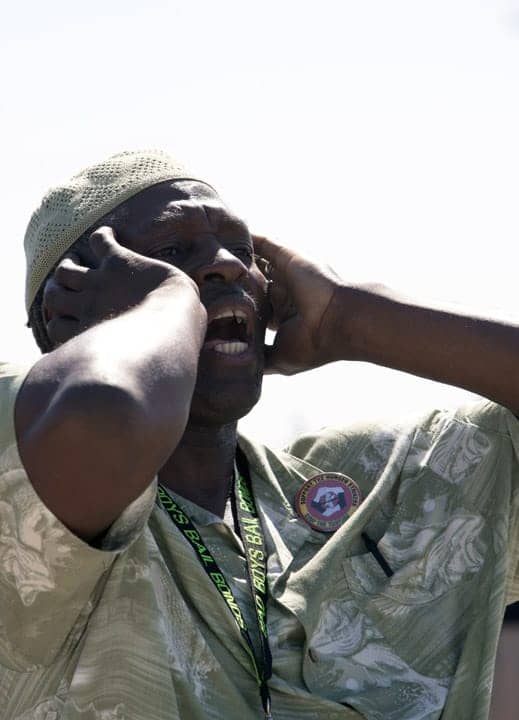
“If we know, then we must fight for your life as though it were our own – which it is – and render impassable with our bodies the corridor to the gas chamber. For, if they take you in the morning, they will be coming for us that night.”
We must build of our support unbreakable bonds with those who daily risk their lives inside concrete boxes of stone, mortar and cement, suffering unbelievable deprivation as they continue to demand to be recognized as men and women fighting for their liberation.
We in minimum security on the outside have an indisputable reality to face: We must stand shoulder to shoulder with our brothers and sisters locked down in the maximum security that being inside represents – against this manifestation of what Michelle Alexander so ably recognizes as a racially redesigned system of caste enslavement in her book, “The New Jim Crow: Mass Incarceration in the Age of Colorblindness.”
“We have not ended racial caste in America; we have merely redesigned it. By targeting Black men through the war on drugs and decimating communities of color, the U.S. criminal justice system functions as a contemporary system of racial control,” she said when she spoke at Riverside Church on May 21, 2011.
Systemic injustice. That is what she is talking about.
We must build of our support unbreakable bonds with those who daily risk their lives inside concrete boxes of stone, mortar and cement, suffering unbelievable deprivation as they continue to demand to be recognized as men and women fighting for their liberation.
Thus, 30,000 prisoners began a hunger strike on July 8, 2013, citing the following five core demands to be met by the CDCR and the governor of California before the hunger strike shall cease:
- Eliminate group punishments and administrative abuse;
- Abolish the debriefing policy and modify gang status criteria;
- Comply with recommendations of the Commission on Safety and Abuse in America’s Prisons and end long-term solitary confinement;
- Provide adequate and nutritious food;
- Create and expand constructive programming.
Among the speakers outside of Corcoran State Prison on July 13 were:
- Marie Levin, younger sister of Sitawa Nantambu Jamaa, who spoke of his 23 years in solitary confinement in Pelican Bay State Prison. Her brother is a plaintiff in the Center for Constitutional Rights lawsuit challenging long-term solitary confinement. She did a solidarity hunger strike for him and other prisoners all on her own;
- Dorsey Nunn, executive director of Legal Services for Prisoners with Children and co-founder of All of Us or None, who denounced SHU conditions as human rights violations;
- Kamau Walton of Critical Resistance, who read a statement of gratitude from the Pelican Bay SHU Short Corridor representatives;
- Alex Sanchez of Homies Unidos, who spoke of the solidarity and unity growing among prisoners in El Salvador; and
- Steven Czifra and Danny Murillo, former SHU prisoners.
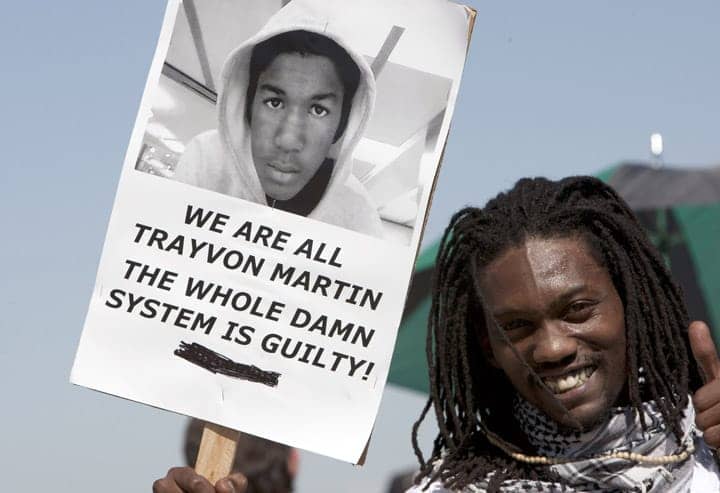
“What this policy says to me is that the culture, heritage, the memory of your ancestors and your political identity are a violation of CDCR regulations, and because of this violation you can be placed in solitary confinement in a cell for 22 hours per day for the duration of your sentence, which could range from a couple of months to the rest of your life.”
There were other speakers who challenged the CDCR’s attempt to colonize people’s human rights to revere their culture, heritage and the memory of their ancestors; who spoke about the denials of medical and mental health care; and who decried the forced sterilization of 148 women in California prisons.
There were many organizations and individuals from throughout the U.S., Canada and beyond. There were families of prisoners, women, children, elders and friends, community members and organizations. Some had traveled long distances to be there.
A disabled person came with her tiny service dog. Araceli Guizar came representing her son, Sergio Alvarez, as did the families and friends of Antonio Guillen, Heshima Denham, Michael Zaharibu Dorrough, Jimmy Baridi Williamson, Alfred Sandoval, Paul Sangu Jones, Christian Gomez (RIP), Sitawa Natambu Jamaa, brothers and cellies Michael and James Lopez, and Brian James, to name but a few.
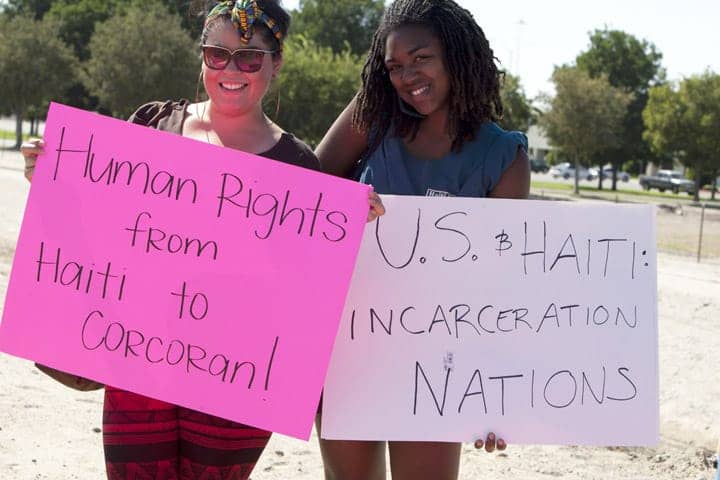
Muslim supporters observing Ramadan, representing many mosques and many men and women prisoners who are Muslim, faced east in silent prayer, while standing in solidarity with prisoners on hunger strike and with the Committee for the Defense of Naturalized and Afro-Mexicans (CCDNAM) led by Wilner Metelus of Haiti, which initiated a hunger strike in Mexico on July 4, 2013, at the doors of the Federal District Government Building, protesting the murder of El Hajj Malcolm Latif El Shabazz and demanding justice. On July 12, hundreds of police attacked the peaceful vigil, badly wounding Metelus and Jah Zakah of Haiti.
Prisoners worldwide stand in solidarity.
There was a wall of solidarity built on a park fence at Cesar Chavez Park by supporters using statements from SHU prisoners and logos from different organizations. After a rally at the park, marchers left on foot and in a car caravan to rally again at Corcoran State Prison.
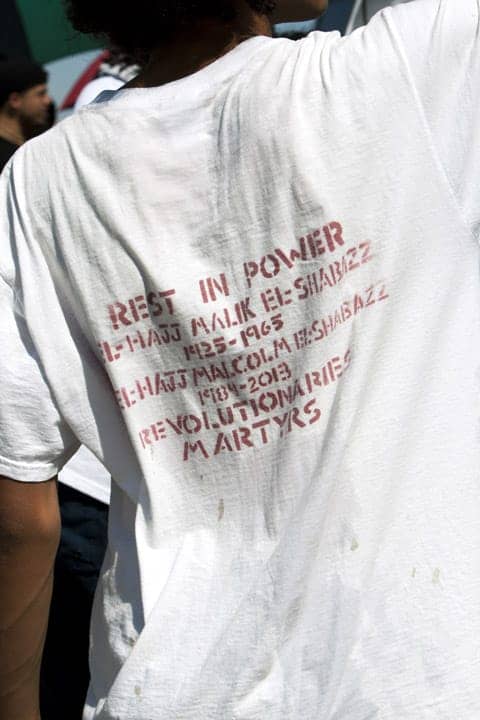
“Stop the torture and free them all” was the protesters’ consensus, because dignity and the right to life are human rights guaranteed for everyone – not options to be dispensed by the few.
Recall too that between 1791 and 1804, the Haitian grassroots successfully fought and won against chattel enslavement of Afrikan people by defeating the greatest military might of the time: the armies of France (twice), Spain and England and $40,000 in foreign aid from then U.S. President Thomas Jefferson to Napoleon of France. Not only did Haiti win decisively, but she stood shoulder to shoulder with and taught others how to win as well.
And Haitian people did this despite the oppressor’s use of Fort Dimanche for the torture and murder of revolutionaries and political prisoners. Named the Dungeon of Death, the infamous Fort Dimanche was built by the French during their occupation of Haiti prior to the 1791-1804 Haitian Revolution.
On July 13, 2013, over 400 people rallied outside of Corcoran State Prison in solidarity with over 30,000 prisoners’ demands to stop the torture and accede to their five core demands. People both inside and outside are responding to the call for solidarity by the thousands.
Departments of Corrections across the U.S. should take note of this echo down through time. They should remember the words of L.D. Barkley, the 21-year-old spokesperson for the Attica prisoners rebelling in September 1971, when he said:
“We are MEN! We are not beasts and we do not intend to be beaten and driven as such. The entire prison populace – that means each and every one of us here – has set forth to change forever the ruthless brutalization and disregard for the lives of the prisoners here and throughout the United States.
“What has happened here is but the sound before the fury of those who are oppressed.”
Solidarity is growing against a voracious monster that does nothing but kill. In the wake of the U.S. government’s state sanctioned murder of Trayvon Martin, the conclusions drawn by the Malcolm X Grassroots Movement’s “Operation Ghetto Storm: 2012 Annual Report on the Extrajudicial Killing of 313 Black People by Police, Security Guards, and Vigilantes“ have borne fruit in the chilling reality of the not guilty verdict issued after only 16 hours of deliberation by a six-member jury, not the peers of Trayvon Martin.
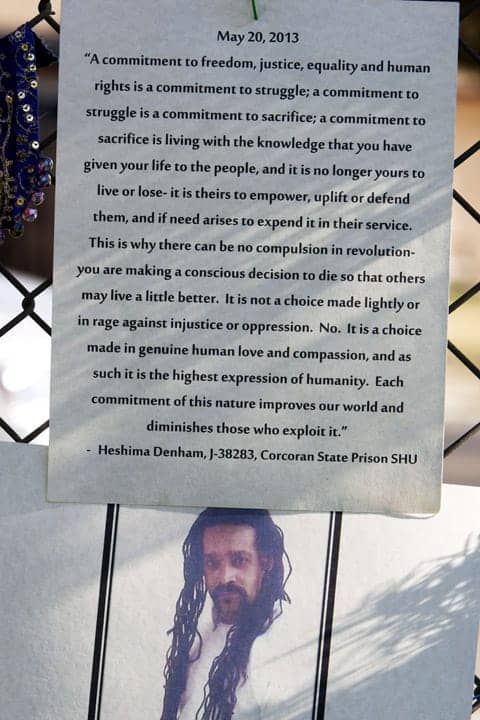
Step into a prison, and the number of hours decreases even more significantly. The number of hours will continue to decrease because this is the legacy of enslaver-rapists like Thomas Jefferson. This is the way that racism works in Amerikkka: Zimmerman’s “fu*king punks” who “always get away” are those like him who have guns, white supremacy and the DOJ strapped to their sides.
Innocence doesn’t matter. And innocence has not ever been a guarantee against imprisonment, enslavement or death.
So what is the color of injustice without end?
The not guilty verdict freed Trayvon Martin’s stalker-killer George Zimmerman, gave him his gun back, re-instated his license to kill, praised him for being a good white supremacist, and continues to say to the world that Afrikan life is worth nothing to the U.S. government and its gun slinging minions, the Department of Justice.
For make no mistake – it was not the putrid George Zimmerman who was on trial; it was all of the Afrikan people of the world, of whom Trayvon Martin was one, a youth just coming into his own.
So hoodie up, everyone – and lock and load. The Klan does not cometh; the Klan is here – and entrenched.
We are fighting for our humanity and our lives.
All power to the people!
A luta continua!
Malaika H Kambon is a freelance photojournalist and the 2011 winner of the Bay Area Black Journalists Association Luci S. Williams Houston Scholarship in Photojournalism. She also won the AAU state and national championship in Tae Kwon Do from 2007-2010. She can be reached at kambonrb@pacbell.net.

 Store
Store


